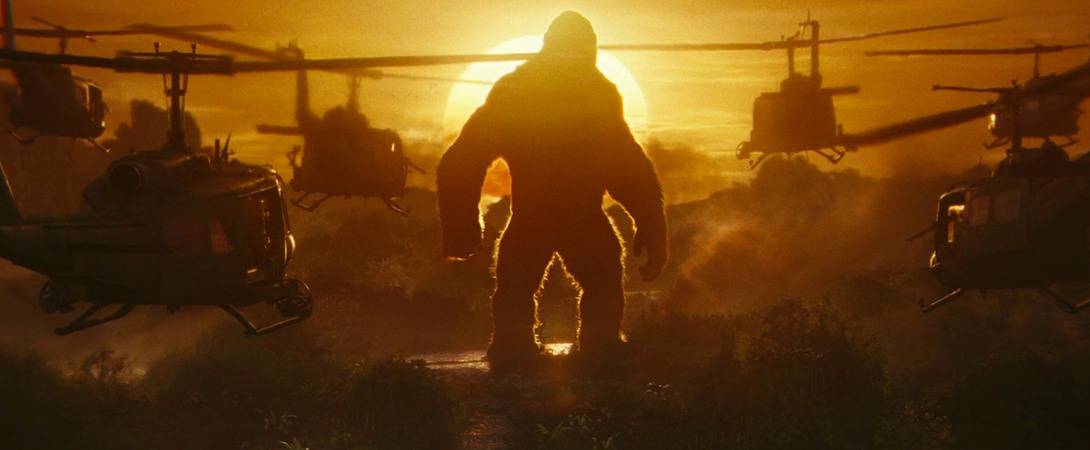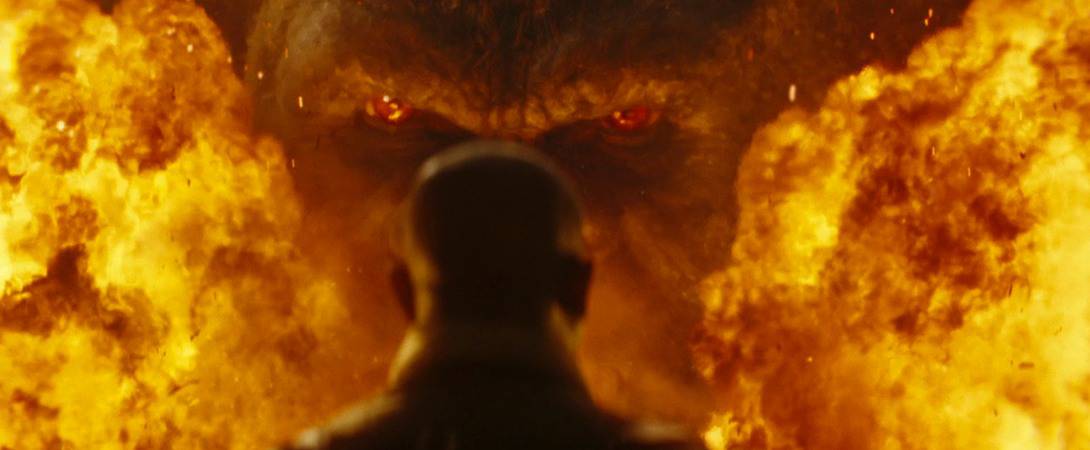Give me a monster, and I’m happy. Give me a monster-bashing another monster, and I’m in love. This desire probably existed when our ancestors gathered around the campfire in the cave, but cinematically, the mad monster party love affair began in 1933 with King Kong. The romance continued afterward wearing the faces of various brutes and beasts, and I am ecstatic whenever a new filmmaker comes to the game with a creature perched on their camera.
Kong: Skull Island had many other brothers and sisters that it had to surpass, or at least confront on equal footing. Director Jordan Vogt-Roberts helped the big guy out by shedding loyalty to his typical narrative and concentrating on the heft required to wear such a royal jungle crown. In focusing on Kong’s majesty, strength, and badassery, Vogt-Roberts revels in a more broad appeal to the monster, an allure often overshadowed by empathy in previous outings. Enlightened? Maybe not. Cool? Hell yeah. No ape cooler.
We know the story. With celebrity comes loneliness. The eighth wonder of the world reigns over his island domain, and he has no one with which to share his riches. He is feared by the natives, both beast and man. Outsiders want to invade and transform him into a sideshow attraction unfit for his talents. They dangle tasty morsels to gain his favor, but in the process of playing with his food, he falls in love with it. Little blonde Ann Darrow should have gone down with a gulp, but the wonder and terror in her eyes put a skip in King Kong’s heart. The gargantuan animal would follow her anywhere, including to the very tippy-top of that alien Empire State Building with its machine gun death from above.
It was beauty killed the beast. Naw. Been there, done that (three times actually). King Kong ’33 is an essential piece of creature cinema, and it is revered for as many reasons as it is reviled for its outdated depictions of tribal savages and damsels in distress. The ’76 remake saddled three magnetic leads against one of the wonkiest man-in-ape costumes ever jammed onto the screen, and the ’05 retelling is an indulgent romance from one filmmaker to another. No one can out-passion Peter Jackson, so a third remake would simply not do. Once Jackson stretched the original James Ashmore Creelman and Ruth Rose screenplay to its outermost limits, there was only one option left for anyone else looking to return the great ape to movie houses: total renovation.

After restoring Godzilla for American audiences in 2014, Legendary Entertainment wanted in on that Marvel Cinematic Universe affluence. The King of the Apes and Jolly Green clashed back in 1965 (King Kong vs. Godzilla) while under the banner of the Toho Company, but the possibilities of a MonsterVerse born from such a pairing today screamed dollar signs. In fact, the tantalizing notion is what brought Legendary over to Warner Bros. in the first place. These movie titans were the new Ali vs. Frazier. Step back, let them fight, and scrape up the cash flooding in their wake.
A small squad of screenwriters would take their turn removing the gloomy tragedy from King Kong’s history. Max Borenstein penned the Godzilla reboot and was the first to take a crack at Skull Island. Draft One involved a prologue transition from the Vietnam War to modern-day, but producers couldn’t wrap their heads around an island that would remain invisible for decades after discovery. Draft Two took place closer to the timeline of the original film trading the Vietnam War for World War I — napalm for mustard gas.
John Gatins (Flight, Need for Speed) took a second pass on Borenstein’s script, relying on a high school teacher’s memory of Vietnam to flesh out the experience. From there, Derek Connolly (Safety Not Guaranteed) put in some time, going so far as to tweet out that the script was the coolest one he had worked on up until that point in time. Who wouldn’t ache to venerate Kong? Dan Gilroy (Nightcrawler, Velvet Buzzsaw) was the final scribe to offer input, but most of his character beats were chopped free from the finished product.
When Vogt-Roberts came in to pitch his take to Legendary, he gravitated towards Borenstein’s Apocalypse Now mashup. Where Peter Jackson’s Kong design embraced gorilla biology, Vogt-Roberts wanted to maintain the supernatural profile of Willis O’Brien‘s 1933 creature. The Skull Island King is more God than ape, walking upright, and towering above his subjects. The image of the beast standing tall before a setting sun while a group of helicopters rain napalm strikes to the core of our primeval brain, and I defy any audience member to resist goosebumps at the sight.
The human plight takes second to the face of awe, and in that regard, Skull Island and King Kong ’33 are similar. Vogt-Roberts populates the land with charismatic leads; Tom Hiddleston, Brie Larson, Samuel L. Jackson, Jason Mitchell, and especially John C. Reilly go a long way in securing our attention during the dull bits without Kong, but the film never kids itself — we’re here to worship. Vogt-Roberts is Kong’s hype man, establishing a god worthy enough to battle another god(zilla). To that effort, we sit back and marvel as the King makes meals out of giant octopuses, drinks marrow from subterranean reptiles, and swats at humans like the nats we are.

As a result of franchise demands, Skull Island leaves its god on his throne. The humans pretend to aid in Kong’s rumble with the carnivorous skullcrawlers, but they’re more nuisance than an actual threat. By his will, the humans live to exit the island. The Eighth Wonder remains and we’re left to ponder the catastrophe coming when he steps from his home turf. Could the god-ape offer anything to that other king of the monsters that Mothra, Rodan, and Ghidorah didn’t already serve up this summer?
For Borenstein, the apocalyptic images were less exciting than the Dante-esque journey through them. As he told Creative Screenwriting, “I liked the idea of people moving upriver to face a misunderstood force that they think of as a villain, but ultimately they come to realize is much more complicated.” Kong as Kurtz, a creature whose existence alters all worldly understanding for the protagonists. Our rule on this planet was only a game of pretend. We always knew there was a heel hanging over our heads, and we deserve the squish, whether from an ancient ape or atomic lizard. The horror, the horror.
I’ll never give up my love for the original King Kong, and it is one of those movies that I could see remade every decade or so. It speaks to the primate brain within us. Jackson engorged the property to nearly unhealthy lengths, and we’re still not done digesting his infatuated interpretation. Give it time. Someone will come around with another slant on the beauty and the beast metaphor. However, for those that love Kong and believe he should stand next to the great movie monsters like Godzilla, the great ape must tear himself from the confines of that particular story. Godzilla would not be King of the Monsters if Toho trapped him inside his 1954 parable.
Kong: Skull Island was the Eighth Wonder’s coming out party and a challenge to the behemoths who came after. He’s ready to meet the big lizard on his global battlefield. Let them fight. Kong will probably go down in round one, but watch out for round two. What was once a champion is now an underdog, and we love an underdog.
The post Loving Beast Over Beauty in ‘Kong: Skull Island’ appeared first on Film School Rejects.
0 comments:
Post a Comment